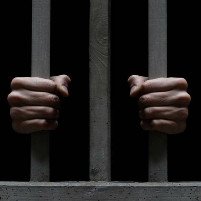A Growing Industry in Hard Times: Prisons
Monday, March 09, 2009

Even in the midst of a struggling economy, in which most states are facing budget deficits, the prison industry has continued to experience significant growth and increased funding. A recent report released by the Pew Center on the States, entitled “One in 31: The Long Reach of American Corrections,” examines “the scale and cost of prison, jail, probation and parole in each of the 50 states, and provides a blueprint for states to cut both crime and spending by reallocating prison expenses to fund stronger supervision of” offenders on probation and parole.
The report provides a detailed look into the exact demographics of the American corrections system population. Here are a few noteworthy observations:
One in 31 adults in America is in prison or jail, or on probation or parole. Twenty-five years ago, the rate was 1 in 77.
Overall, two-thirds of offenders are in the community, not behind bars. 1 in 45 adults is on probation or parole and 1 in 100 is in prison or jail.
When looking at race and geography the numbers reveal stark differences:
1 in 11 black adults (9.2 percent) versus 1 in 27 Hispanic adults (3.7 percent) and 1 in 45 white adults (2.2 percent); 1 in 18 men (5.5 percent) versus 1 in 89 women (1.1 percent).
In one block-group of Detroit’s East Side, 1 in 7 adult men (14.3 percent) is under correctional control.
In Georgia, 1 in 13 adults is behind bars or under community supervision.
The report studies the cost of current sentencing and corrections policies. States are estimated to have spent a record $51.7 billion on corrections in FY2008. With the addition of local, federal and other funding, the national correctional spending totals $68 billion—a 300 percent increase over 20 years. This growth rate outpaced other essential government services such as education, transportation and public assistance. Only Medicaid spending has grown faster.
New data collected by the Pew Center on the States for the report provides the first breakdown of correctional spending by prisons, probation and parole in the past seven years. Thirty-four states made complete data available. Here are some findings:
In FY 2008, the 34 states spent $18.65 billion on prisons (88 percent of corrections spending), but only $2.53 billion on probation and parole (12 percent).
For eight states where 25 years of data were available, spending on prisons increased by $4.74 billion from FY 1983 to FY 2008, while probation and parole spending increased by only $652 million.
For the 34 surveyed states, in FY 2008, the average inmate cost was $79 per day, or nearly $29,000 per year. That is 22 times more spending per day than to supervise offenders in the community, which cost from $3.42 per day for probationers to $7.47 per day for parolees, or about $1,250 to $2,750 a year.
Despite this increased spending, recidivism rates (released criminals who commit another crime) remain largely unchanged. Research shows that appropriately resourced and managed community supervision programs for lower-risk, non-violent offenders can cut recidivism by as much as 30 percent. Research also shows “that prisons are housing too many people who can be managed safely and held accountable in the community at far lower cost,” said Adam Gelb, director of the Pew Center on the States’ Public Safety Performance Project, which produced the report. As a result, the report provides states with some guidelines on how to improve their community corrections systems, save money and reduce crime:
Sort offenders by risk to public safety to determine appropriate levels of supervision;
Base intervention programs on research to reduce recidivism;
Harness advances in supervision technology;
Impose swift and certain sanctions for offenders who break the rules of their release but who do not commit new crimes;
Create incentives for offenders to succeed;
Establish methods for measuring progress.
One in 31 U.S. Adults are Behind Bars, on Parole or Probation (Pew Charitable Trusts)
One in 31: The Long Reach of American Corrections (Full report) (PDF)
- Top Stories
- Unusual News
- Where is the Money Going?
- Controversies
- U.S. and the World
- Appointments and Resignations
- Latest News
- Can Biden Murder Trump and Get Away With it?
- Electoral Advice for the Democratic and Republican Parties
- U.S. Ambassador to Greece: Who is George Tsunis?
- Henry Kissinger: A Pre-Obituary
- U.S. Ambassador to Belize: Who is Michelle Kwan?






Comments